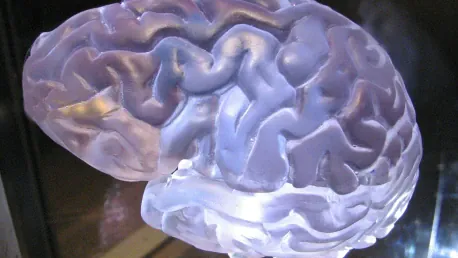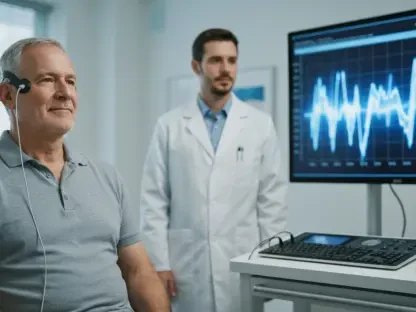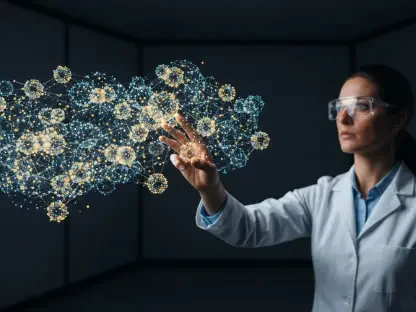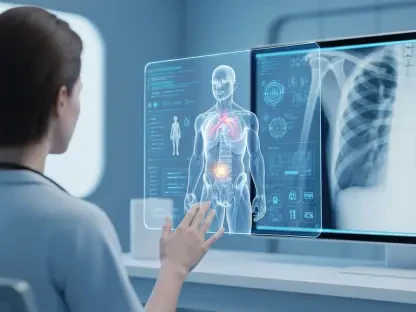The collaborative research effort between UC Berkeley and UC San Francisco introduces a groundbreaking speech neuroprosthesis designed to restore naturalistic speech for individuals experiencing severe paralysis. This pioneering technology addresses the critical issue of latency, allowing brain signals to be converted into audible speech almost instantly. For individuals who have lost their ability to speak due to paralysis, this innovation signifies a return to meaningful communication. The field of brain-computer interfaces (BCIs) has seen considerable advancements in recent years, but the issue of latency has been a persistent obstacle. The groundbreaking work from these two institutions aims to eliminate this barrier, promoting a seamless and effective means of communication for those in need.
Tackling Latency in Speech Neuroprostheses
Latency has been a significant hurdle in the development of effective speech neuroprostheses. This time delay between the attempt to speak and the production of sound has historically undermined natural communication for paralyzed individuals. The innovative streaming method developed leverages artificial intelligence to synthesize brain signals into speech rapidly. High latency disrupts the flow of conversation, making it difficult for individuals to engage in interactive communication. The researchers adopted AI-based modeling to drastically reduce latency, offering new hope for smoother and more naturalistic speech synthesis.
The AI-based modeling used by the research team drastically reduces latency, offering nearly instantaneous speech decoding capabilities. This breakthrough mirrors the technology found in consumer devices such as Alexa and Siri, translating neural data into audible voice swiftly and fluently. By employing algorithms similar to these commercial speech recognition tools, the neuroprosthesis can provide real-time processing and a natural conversational experience. Such technology is vital for individuals who have lost their ability to speak, as it enables them to interact with their environment and communicate their needs and thoughts effectively.
Clinical Implications
Edward Chang’s clinical trial at UCSF exemplifies the real-world application potential of this technology. Through high-density electrode arrays recording neural activity directly from the brain surface, speech neuroprosthesis looks promising in enhancing the quality of life for individuals who have lost their ability to speak due to paralysis. This technology not only aids in communication but also empowers patients by giving them a voice after long periods of silence. The practical application of BCIs in a clinical setting marks a significant milestone in medical technology.
The latest advances in AI are accelerating the practical use of BCIs, with significant implications for patients suffering from severe speech impairments. The positive feedback from clinical trials indicates the transformative impact of this innovation. Patients reported feeling more connected and present in conversations, suggesting that the technology not only facilitates communication but also enhances emotional well-being. As the technology continues to develop, there is potential for even broader applications in the future, providing benefits beyond speech restoration.
Versatility Across Brain Sensing Interfaces
Researchers have demonstrated the adaptability of their approach across various brain sensing interfaces. The technology has shown effectiveness with microelectrode arrays (MEAs) that penetrate the brain’s surface, as well as non-invasive recordings like sEMG, which measure muscle activity using facial sensors. This flexibility ensures that the neuroprosthesis can be tailored to meet the individual needs of patients, depending on the severity and location of their paralysis.
This versatility underscores the method’s robustness, allowing accurate brain-to-voice synthesis across different modalities. The adaptability ensures that the neuroprosthesis can be applied to a wide range of patients with different needs and conditions. For instance, patients who may not be suitable candidates for invasive procedures can still benefit from the technology using non-invasive methods. The ability to translate neural activity from various sources into clear and fluent speech opens up new avenues for treatment and enhances the accessibility of this life-changing technology.
Decoding Neural Data into Speech
The neural data sampling from the motor cortex, responsible for speech production, serves as the core mechanism of the neuroprosthesis. AI is used to decode neural activity into speech, intercepting signals where thoughts translate into articulation. This process involves capturing the brain’s electrical signals and interpreting them into meaningful speech patterns. The precision of this decoding process is crucial for enabling accurate and natural-sounding speech.
Training this algorithm involved silent speech attempts by the subject, providing vital neural activity data without vocalization. This approach maps brain activity to target sentences effectively, harnessing the subject’s pre-injury voice for the output. By using pre-injury voice data, the neuroprosthesis can generate speech that closely resembles the individual’s natural voice, providing a more personalized and authentic communication experience. This technique ensures that the output feels familiar and comfortable for the user, enhancing their sense of control and confidence.
Overcoming Residual Vocalization Challenges
The lack of residual vocalization was addressed through AI-simulated audio details. A pretrained text-to-speech model generated the necessary audio, simulating the target and producing the output in a voice resembling the subject’s pre-paralysis speech. This innovation allows for the continuation of personal identity in communication, maintaining the user’s unique vocal characteristics. By preserving the natural voice, users can retain a sense of themselves in their interactions, contributing to their overall well-being.
This AI utilization ensures that the synthesized speech remains authentic and familiar to the individual, enhancing their sense of embodiment and control over the speech neuroprosthesis. The ability to produce speech that sounds close to their natural voice provides a psychological boost, helping users feel more in tune with their communication device. Overcoming the challenge of residual vocalization is a significant step forward in ensuring the technology is practical and user-friendly.
Achieving Real-Time Streaming
The new streaming approach marks a significant leap from previous studies, with a remarkable reduction in latency for speech synthesis. Audible output is now produced within one second of detecting the intent to speak, maintaining continuous decoding for uninterrupted communication. This near-instantaneous response is critical for natural conversation flow, allowing users to engage in real-time interaction without noticeable delays. The resulting speech is seamless and coherent, significantly improving the user experience.
Detailed speech detection methods measure latency, ensuring timely identification of neural signals indicating speech attempts. Faster processing has not compromised accuracy, providing precise and naturalistic speech decoding. The balance between speed and accuracy is vital for effective communication, ensuring users can speak fluently and naturally. This advancement makes it possible for individuals with paralysis to participate in conversations in a manner that closely mimics natural speech patterns.
Generalization to Unseen Words
Validation of the model’s capabilities included tests with words not featured in the training dataset. Rare words from the NATO phonetic alphabet exemplified the model’s ability to generalize, demonstrating its proficiency in learning and synthesizing diverse sounds. This ability to adapt to new vocabulary ensures the neuroprosthesis can handle varied linguistic inputs, making it more versatile in everyday communication scenarios. The capacity to understand and generate unseen words is crucial for practical use, as users often encounter new terms in regular conversations.
This capability ensures the neuroprosthesis’s effectiveness in real-world scenarios, accommodating an extensive range of vocabulary and speech patterns. Users can communicate more freely without being restricted to a limited set of pre-programmed words or phrases. The adaptability of the technology highlights its robustness and potential to significantly enhance the communicative abilities of individuals with severe speech impairments, paving the way for broader implementation and acceptance.
Enhancing User Experience
Feedback from the subject, Ann, highlights the advancements brought by the streaming synthesis approach. She reported a heightened sense of control and embodiment, attributed to the real-time hearing of her own voice during speech attempts. The ability to hear herself speak as she forms words provides a more intuitive and satisfying experience. This sensory feedback is vital for maintaining a strong connection with the communication device, reinforcing the sense of normalcy in everyday interactions.
This user experience underscores the potential for neuroprostheses to enable more naturalistic communication, improving the quality of life for individuals with severe paralysis. The integration of real-time auditory feedback creates a more seamless and immersive experience, allowing users to communicate with greater ease and confidence. By addressing both the technical and emotional aspects of speech synthesis, the technology significantly enhances the user’s overall communication capability.
Future Directions
The research team remains focused on refining this speech neuroprosthesis technology, aiming for continuous improvements. Efforts include enhancing speech generation algorithms, incorporating expressivity into output voice, and decoding paralinguistic features such as tone, pitch, and loudness. These enhancements aim to make the speech more expressive and natural, closely mimicking the nuances of human communication. The ability to convey emotions and subtleties through speech is critical for meaningful interactions.
Ongoing work seeks to bridge the gap to fully naturalistic speech restoration, propelled by AI advancements and a collaborative scientific effort. The journey towards perfecting speech neuroprosthesis involves multidisciplinary cooperation, drawing expertise from fields such as neuroscience, engineering, and artificial intelligence. Future developments will likely bring even more sophisticated solutions, further enhancing the lives of those affected by severe paralysis.
Support and Contributions
The project received extensive support from entities like the Japan Science and Technology Agency’s Moonshot Research and Development Program and philanthropic foundations. This collaboration highlights the joint commitment to advancing technology for individuals affected by paralysis. The collective efforts and funding from various institutions underscore the importance of this research and its potential impact on improving lives.
The support and contributions have been instrumental in achieving the milestones in developing this neuroprosthesis. Continued investment and collaboration will be essential in pushing the boundaries of what is possible, ultimately leading to the realization of fully naturalistic and expressive speech for all users.
Conclusion
Latency has been a major obstacle in developing effective speech neuroprostheses, causing delays between an attempt to speak and sound production, which undermines natural communication for paralyzed individuals. To address this, researchers developed an innovative streaming method that uses artificial intelligence (AI) to quickly convert brain signals into speech. High latency disrupts conversation flow, making interactive communication challenging. However, by adopting AI-based modeling, researchers have significantly reduced latency, offering hope for smoother and more natural speech synthesis.
The research team’s AI-based modeling drastically cuts latency, enabling nearly instantaneous speech decoding. This breakthrough resembles technology in consumer devices like Alexa and Siri, rapidly translating neural data into audible voice. Using algorithms similar to commercial speech recognition tools, the neuroprosthesis provides real-time processing and a natural conversational experience. This technology is crucial for people who have lost their ability to speak, as it allows them to interact with their surroundings and communicate their needs and thoughts effectively.









